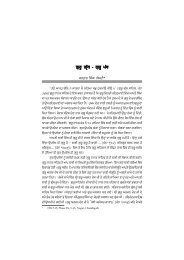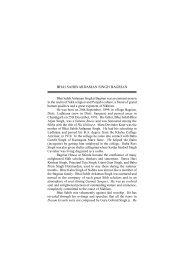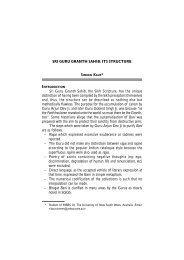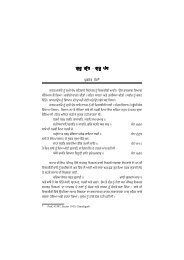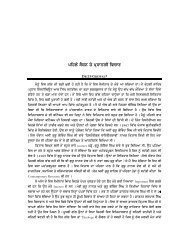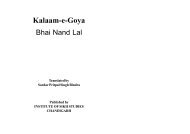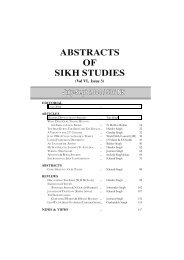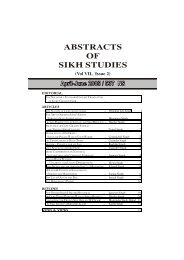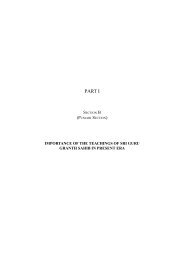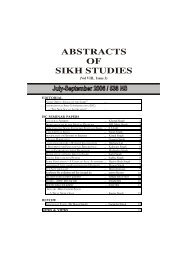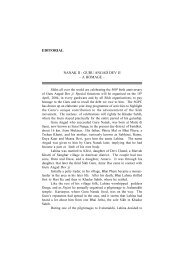You also want an ePaper? Increase the reach of your titles
YUMPU automatically turns print PDFs into web optimized ePapers that Google loves.
72ABSTRACTS OF SIKH STUDIES : JAN-MARCH <strong>2006</strong> / 537-38 NSautonomy and has militantly defied the government which partly ledto the invasion <strong>of</strong> the <strong>Sikh</strong> Golden Temple in Amritsar. To Akbar, the<strong>Sikh</strong>s were a religious community deserving imperial support. ToJahangir, they were a growing political force that potentially threatenedthe Empire. To Aurangzeb, the <strong>Sikh</strong>s were dangerous heretics to bestamped out at any cost. To the successors <strong>of</strong> Aurangzeb, the <strong>Sikh</strong>swere a major military and social force pulling the Empire apart. As aseparate and militant community, the <strong>Sikh</strong>s still find themselves partlyforeigners in their own country, suspicious <strong>of</strong> and suspected by thedominant government.THE SIKH RENAISSANCE AND NEED FOR AN INTERNATIONALAPEX BODYIn the early 20 th century, <strong>Sikh</strong>ism faced almost the same type <strong>of</strong>situation we face today. <strong>Sikh</strong>ism was on guard from all sides, Hinduismhad its Arya Samaj Movement which aimed at absorbing <strong>Sikh</strong>ism intothe fold <strong>of</strong> Hinduism, and the newly established Christian Missionarieswere also very active among the <strong>Sikh</strong>s, even to the extent <strong>of</strong> convertinga <strong>Sikh</strong> Royal Household. The <strong>Sikh</strong> nation rose to the occasion andstarted the Singh Sabha Lehr which then evolved into the GurdwaraSudhaar Lehr culminating in the hugely successful Morchas <strong>of</strong> theShiroamni Akali Dal which brought British Govt to its knees, and<strong>Sikh</strong>s tasted sweet success in the formation <strong>of</strong> the SGPC as a sort <strong>of</strong>an Apex Body to manage all historical gurdwaras in the Punjab region.Despite many decades <strong>of</strong> trying, the <strong>Sikh</strong>s have been unable to getthis extended to cover the whole <strong>of</strong> India, under an All India GurdwaraAct.Now we face an almost similar situation, with one big difference.<strong>Sikh</strong>s now are spread out all over the World and the Diaspora <strong>Sikh</strong>sform a substantial section <strong>of</strong> the <strong>Sikh</strong> Nation. The SGPC is governedby an Indian Act confined to only Punjab state in India and is, therefore,inadequate to satisfy all <strong>Sikh</strong>s worldwide. Hence the need for anInternational Confederation <strong>of</strong> <strong>Sikh</strong>s.But the question arises ..Why Confederation? The answer is thatit obviously works, based on tried and successful Misl System/Gurmattas/consultations/democracy <strong>of</strong> Punj instead <strong>of</strong> one individual.By the time <strong>of</strong> the late Seventeenth Century, when Guru Tegh



